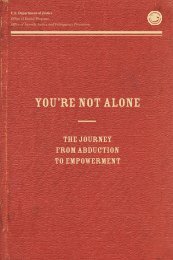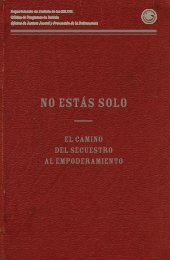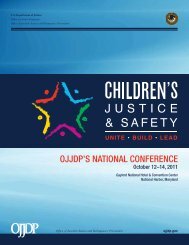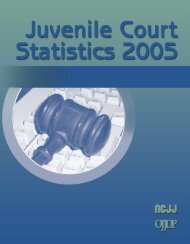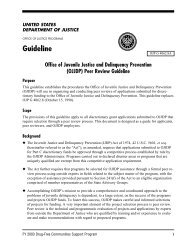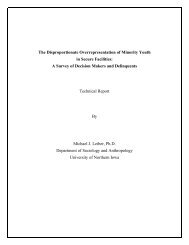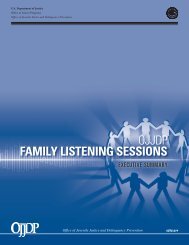Promising Strategies To Reduce Gun Violence - Office of Juvenile ...
Promising Strategies To Reduce Gun Violence - Office of Juvenile ...
Promising Strategies To Reduce Gun Violence - Office of Juvenile ...
Create successful ePaper yourself
Turn your PDF publications into a flip-book with our unique Google optimized e-Paper software.
Pr<strong>of</strong>ile No. 1 (continued)<br />
arsenal. CLC also provided legal assistance<br />
with organizational development<br />
issues such as drafting bylaws and articles<br />
<strong>of</strong> incorporation.<br />
❖ Capacity to address physical problems<br />
and to provide communitybased<br />
alternatives to incarceration.<br />
Small-scale, physical improvements to<br />
a neighborhood—for example, turning<br />
a local dumping ground into a community<br />
garden in the course <strong>of</strong> a weekend—are<br />
enormously important to<br />
communities in crisis. In addition to<br />
adding to the area’s visible community<br />
assets, these incremental neighborhood<br />
improvements increase community<br />
spirit and build support for future residential<br />
action. Recovering addicts and<br />
other nonviolent ex-<strong>of</strong>fenders can become<br />
important resources for this effort,<br />
performing community service as members<br />
<strong>of</strong> work crews that build communities<br />
ravaged by the kinds <strong>of</strong> activities<br />
in which they were once engaged.<br />
❖ Other support services. Each CCP<br />
site has developed additional programs<br />
and services that are considered necessary<br />
to the success <strong>of</strong> the initiative. For<br />
example, four sites have worked with<br />
the Alternative Sentencing Unit to<br />
establish formal and informal systems<br />
to support recovering addicts. Other<br />
CCP sites have tried to secure additional<br />
resources for youth and have<br />
either established links with existing<br />
agencies or developed afterschool and<br />
summer programs <strong>of</strong> their own. Faith<br />
organizations like the Union Methodist<br />
Memorial Church also have been active<br />
in some CCP areas, providing<br />
meeting space, transportation, and<br />
support services for recovering substance<br />
abusers.<br />
By the end <strong>of</strong> 1996, dramatic decreases in<br />
crime were being reported in CCP areas. In<br />
Boyd Booth, the pilot site, violent crimes<br />
were reduced by more than 50 percent between<br />
1993 and 1996. There also was evidence<br />
<strong>of</strong> increased law enforcement activity: the<br />
number <strong>of</strong> arrests doubled or tripled in many<br />
core communities during that same period.<br />
HotSpot Communities<br />
In March 1997, in large part because <strong>of</strong> the<br />
success <strong>of</strong> the CCP effort, the Governor <strong>of</strong><br />
Maryland launched the HotSpot Communities<br />
(HSC) Initiative as the next generation<br />
<strong>of</strong> community-based crime prevention. HSC<br />
incorporated all the main features <strong>of</strong> CCP<br />
and added several others. HSC sites had to<br />
include the following core elements:<br />
◆ Community mobilization.<br />
◆ Community policing.<br />
◆ Community probation (including intensive<br />
supervision <strong>of</strong> adult and juvenile<br />
probationers and parolees through Operation<br />
Spotlight).<br />
◆ Community maintenance (use <strong>of</strong> city code<br />
enforcement, <strong>of</strong>fender work crews, civil<br />
legal remedies, and rapid response to<br />
“broken windows”).<br />
◆ Youth prevention (afterschool programs,<br />
truancy and curfew enforcement, partnerships<br />
with schools and law-enforcement<br />
agencies).<br />
◆ Local coordination <strong>of</strong> the Baltimore CCP/<br />
HSC program by The Mayor’s Coordinating<br />
Council on Criminal Justice.<br />
In addition, HSC areas could adopt six enhancing<br />
elements: community prosecution,<br />
juvenile intervention, CPTED measures,<br />
victim outreach and assistance, community<br />
support for addiction recovery, or housing<br />
and business revitalization.<br />
22 <strong>Promising</strong> <strong>Strategies</strong> <strong>To</strong> <strong>Reduce</strong> <strong>Gun</strong> <strong>Violence</strong>



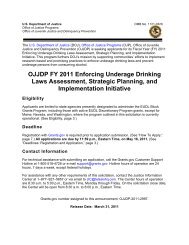
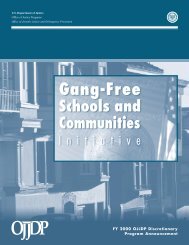
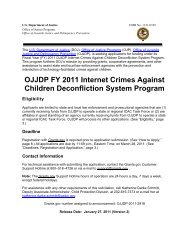
![Chapter 5 [PDF] - Office of Juvenile Justice and Delinquency ...](https://img.yumpu.com/46584340/1/190x245/chapter-5-pdf-office-of-juvenile-justice-and-delinquency-.jpg?quality=85)

